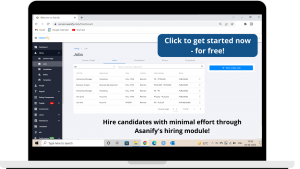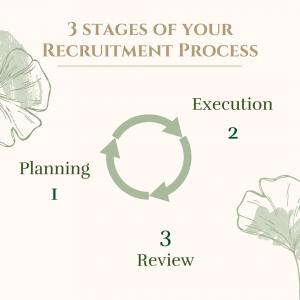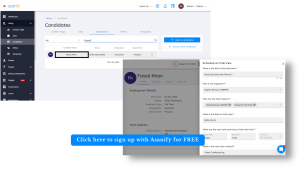A recruitment process can make or break the quality of candidates you hire. It could also play a major role in whether you are wasting time or not. Meaning? Are you wasting your time on useless processes or is each step in the recruitment process adding value and helping pick out the best candidate?
As a startup, each candidate you hire will either help you grow 10x or slow you down just as much. So how do you plan a recruitment process so airtight that you never falter or make a wrong choice ever again?
In this blog, I have written a detailed guide on recruitment processes and how you can create one for your small SME!
- What is a recruitment process in HR?
- Why is it important to have an efficient recruitment process in HRM?
- What is the difference between recruitment and selection?
- 3 aspects of a recruitment process
- Stages in a recruitment process
- Possible rounds used in the selection of candidates
- How to pick the right combination of rounds for an efficient recruitment process?
- Sources of recruitment of candidates
- How long should a recruitment process ideally take?
- Template of an ideal start-up recruitment process
- Summary – Recruitment process flowchart
- FAQs
Click here to jump straight to the FREE downloadable template of a start-up’s ideal recruitment process
What is a recruitment process?
A recruitment process is a process a company puts in place to screen candidates before they are selected, hired and then onboarded. Why am I mentioning selected, hired and onboarded separately? Because all 4 of these are different from the next. We will see the difference between recruitment and selection (often used interchangeably) a little later.
For now, let’s just focus on the recruitment process. A company can have multiple stages and steps in a recruitment process. And this can and ideally should vary based on the role that an HR is hiring for.
Why should they be different? Because each role has different requirements in terms of qualifications, and the candidate’s personality characteristics. The recruiter should be able to judge effectively if the candidate is a perfect fit for the role.
For example, for a sales rep, who has to deal with potential clients in stressful situations, a behavioural interview or mock sales pitch might be great as a part of the process. For a fresher being hired to generate leads for a company, just an interview to get to know the candidate might be sufficient. Or, for a content writer, an assignment asking them to share a write-up within a stipulated time followed by an interview is ideal!
Why is it important to have a proper recruitment process in place?
There are many reasons why having a great process is important. Here are a few!
An efficient recruitment process helps you save time
And by this, I mean yours and the applicants!!
A lot of people make the mistake of asking candidates to “Walk me through your CV”. Why am I saying waste? Because in an interview, if you spend time listening to what is already written down in front of you, how will you have the time to get to know the candidate?
An interview should be used to understand things that haven’t already been covered in the previous round of the recruitment process.
And this is just one example of the most common ways people lose time in a recruitment process. By planning well, and ensuring rounds don’t overlap with each other, you can get to know each candidate better, and then make better, strategic and well-informed decisions
An amazing recruitment process helps build employer brand
As an applicant applying for a new job, it becomes extremely annoying when the process is not planned well. When an HR suddenly throws additional rounds at you or doesn’t give you enough information about what’s happening, it sends the message that the company doesn’t care about its employees or applicants.
There are some companies that go way beyond the extra mile, giving candidates constant reminders or even a simple check-in message saying – “Hope you’re having a smooth and bump-free experience. Feel free to reach out to us in case of queries regarding the process.” Small things like this go a long way when it comes to employer reputation. And it plays a role in the quality of future applicants too.
An awesome recruitment process ensures the right candidates are selected in a timely manner
Remember, a new employee joining a company is always a two-way street. The company is making the choice of a candidate, while the candidate is picking a company.
When you have the right recruitment processes in place for the right role, you make sure that the right person gets picked. And I mean this both ways. The right person for the job, but also, the person feels like they have picked the right company.
A great recruitment process ensures a positive candidate experience
As I mentioned in the section on employer branding previously, a well thought through and planned recruitment process ensures an amazing candidate experience. But why is it important to provide candidates with a positive experience?
Very often companies come across candidates who are amazing and have great potential. But they don’t fit in the role they applied for, so they get rejected at first. Then a few months later, a role opens up that seems to be perfect for this candidate. Providing a positive candidate experience can increase the chances of the candidate joining you despite being rejected the first time.
Click here to jump straight to the FREE downloadable template of a start-up’s ideal recruitment process
What is the difference between a recruitment process and selection?
A lot of people make the common mistake of confusing and interchanging the two. We’ve already seen that the recruitment process is a “process” of screening applicants for any particular role. Selection, on the other hand, is not a process. It is the final act of selecting a candidate or multiple candidates from the pool of applicants after the recruitment process is over.
So, technically if you look at it, the recruitment process comes first. That is followed by the selection of the final candidates who get job offers. These candidates are hired in the form of being sent offer letters and employee appointment letters. (Click on their respective links to download templates for these letters).
After they are hired, these new employees are onboarded into the company.
3 aspects of the employee recruitment process
There are essentially 3 phases that must be included in every recruitment process.
These are fairly obvious, but people often jump to phase 2 without having completed phase one properly. So, here’s what you should be doing.
Plan your recruitment process
Step one to anything in business is coming up with a great plan. Sit down with the manager and understand what kind of a candidate they are looking for. This includes
- Personality traits
- Qualification of the candidate
- Job description and day to day tasks
This will help you understand what kind of rounds you should include in your recruitment process. You must also keep in mind various ways in which you can assess every candidate’s KSAs. What are a candidate’s KSAs?
- Knowledge
- Skills
- Abilities
You need to be able to judge every applicant’s KSAs correctly, and in a manner that doesn’t take up too much time. Overall, these are the 6 aspects you should consider, the first 3 focus on the job and the next 3 focus on the candidate. Working together, they will help you come up with an efficient and impressive recruitment process.
Execution of the recruitment process
Once you have a well-planned process, execution isn’t all that difficult. Make sure you have the logistics in place for execution. This includes things like scheduling or the location of the rounds- be it interviews, tests or discussions.
Review the recruitment process to check for areas of improvement
Review isn’t a part of the recruitment process as such. But, reviewing your process on various parameters will help you tweak it as and when needed and hence make it better with time. Consider factors such as
- Length of the process
- Time per hire
- Cost per hire
- Candidate experience
- Hiring manager’s experience
- Successful hires made
Stages in an ideal recruitment process
There are many many steps and possible rounds that need to be considered while planning a recruitment process. They are listed and explained in detail below!
1. Human resource planning or Recruitment process planning – (Identifying vacancy)
We saw earlier, that planning is the first step to anything that we do in a business. So, even here, demand forecasting and planning are very important.
You need to understand the job openings within your company, and also what those openings will look like a week or a month from now. Sometimes it takes time to hire a new candidate, and if the role you’re hiring for becomes redundant in your company within a month, then there’s no point!
For example, you’re looking to hire 5 new HR employees who can manage payroll, but at the same time, you are looking for a vendor who can provide you with an HRMS & Payroll software, once you have the software in place you won’t need to 5 HR employees. You’ll at the most need 1 or 2 employees depending on the size of your company.
Another example is, very often, companies recruiting from college campuses hire and offer jobs to students months in advance. They need to make sure that when the student actually joins the company, their jobs still add meaning and value to the organization.
2. Write a job description for the role at the very beginning of the recruitment process
This step is important because by looking at the job description, a candidate will decide whether to apply or not.
A very high demanding JD will discourage applicants from applying while simplified job descriptions will result in people not qualified also applying.
3. Posting ads about the job opening
Once you know the roles you need to hire for, you need to write down job descriptions for each of them and find suitable channels to post them on. You can read more about job descriptions, how to write them, and also download templates for whichever JD you need by checking out our blog on job descriptions here!
4. Screen candidates and list down the ones you want as part of your recruitment process
Later in this blog, I will talk about the various rounds and processes you can conduct to select candidates better. You can either have 1 round in case of few applicants or a process that goes on for as many as 8-10 rounds (tedious, I know!)
5. Select the promising candidate or candidates (selection process)
Once you have gone through all the rounds of the selection process, you select your candidates and make them job offers. Do this by downloading the job offer letter template from here and sending it to the applicant.
6. Evaluating the recruitment process to make changes for next time
This one goes without saying, you need to evaluate the recruitment process to see if it is effective, if it results in quality candidates being hired and within a good amount of time. Based on these things, you will be able to make corrections in the recruitment process as needed.
Click here to jump to the FREE downloadable template of an ideal startup recruitment process
Possible rounds used for the selection of candidates in the recruitment process
Now, how do you select the candidate? You can conduct as few as 1-2 rounds or as many as 8-10 rounds in your recruitment and screening process. But that should vary depending on
- The seniority of the role
- The number of applicants
The higher the two of these factors/numbers go, the more rounds you should ideally have. Now, what rounds could you possibly have ad how are they different from each other? Read on to find out!
Initial CV or Resume screening
This goes without saying. Whenever you post a job opening anywhere, you could get 100s or even 1000s of applicants. Even if you don’t get as many as 100 and are at 50 applicants or 20, your first step should always be screening resumes. This is because this is the fastest way to eliminate people who are either underqualified or not a good fit in general.
It’s fast, it’s cheap and honestly, it’s very very convenient.
Behavioural or psychological assessments
In a lot of big companies, they conduct a series of psychological tests and assessments to ensure that the candidates they are hiring are mentally fit for the job. These tests can be done online from the comfort of your home. They also require very little effort from the HR manager’s side. It’s just a matter of setting up the test for the applicants.
A great example or set of references is the Mettl aptitude tests that many college institutes and even companies use.
Written or Aptitude tests
This step in the process is to ensure that the candidate applying has the base level of aptitude and logical skills required for the job. Contrary to popular belief, these tests don’t require any prior prep on behalf of the candidate because they are aptitude tests and not memory-based exams. Similar to the psychological assessments, they require minimal effort from HR.
Group discussion rounds
If you are someone who recently started a job and was picked up during your campus placement rounds, they may seem awfully familiar, no? This is by far one of the most commonly used methods of screening candidates on campus.
While aptitude tests are also commonly used, this is one of those rounds that hiring managers just can’t seem to live without. This round usually works with as few as 5 or as many as 12 candidates at a time and requires some effort on behalf of the HR manager. The group is given a topic, case or situation. They are then required to put forth their points and discuss and convince other candidates based on their views.
This becomes useful when awareness of current events or general knowledge needs to be checked. It also becomes convenient when you want to check candidates’ confidence and ability to put across their points even in stressful situations.
Technical tests or exams
When recruiting for roles in the finance department or even in the case of engineers, technical exams become very important. They test the generic knowledge of the individual in the field they wish to work in.
Group interviews
What are group interviews and how are they different from group discussions? Sometimes, instead of giving one single topic and asking a group of 5-12 candidates is discuss it, interviewers either
- ask a series of questions that they go around asking each candidate. The candidates must answer them in front of the whole group.
OR
- The group interview consists of only a single question and the group is required to work together, have a discussion and come up with one single solution to the question
This helps the interviewer understand how each candidate works in a group. It brings out candidates’ negotiation and communication skills very well. A group interview also shows how well a candidate is able to (or not) hold their ground amidst opposing viewpoints and how rigid or fickle they are with the viewpoints.
Personal interviews
This is by far the most used and abused method of screening candidates. Why abused? Because so many people get it wrong and don’t even realise it. If you already know something, would you go around asking people that thing? No right? Then why do so many of us do that in interviews?
Questions like walk me through your CV, elaborate on your work experience, tell me where you did your post-graduation and so on are already mentioned in the resume or CV in front of you. So why do we waste time on them? The best way to make the most of any interview is to ask the candidate things that you don’t already know. But first, you’ll need to actually go through the CV before (rather than during) the interview.
Questions such as
- Why they did a particular course
- What drives them to be better
- Their number-one inspiration in life and so on.
These things aren’t in the CV, it’s extra information that will help you understand the applicant better.
Channels through which you can conduct personal interviews
While by definition, a personal interview is a one on one interview with the candidate, there are multiple channels through which you can conduct the interview. They are
- In-person interview
- Telephonic interview
- Video interview (where video being turned on is required, meaning you wish to observe the body language of the candidate)
You can now also set up an interview with a candidate (as a part of your recruitment process) via Asanify in 3 easy steps!
- Add the candidate as a ‘candidate’ on Asanify
- Fill in details on the candidate’s profile (the profile that you just made)
- Schedule the interview
The entire process of managing multiple candidates at various stages of the recruitment process can be made extremely easy through Asanify. It will quite literally Asanify your life.
Click here to jump straight to the FREE downloadable template of a start-up’s ideal recruitment process
How to pick the right combination of rounds for an efficient recruitment process?
Now it goes without saying that you cannot have all the above-mentioned rounds in your recruitment process. Even having 5 in one process would be absurd!!
But there are certain factors that play a huge role in how you decide which other rounds to pick and which not to. Some of the factors to consider are
- The number of applicants. (This is something you’ll have to forecast based on prior experience in order to plan in advance)
- The seniority of the role (The more senior the role, the more thorough the process should be)
- Technical requirements of the role (This may require written tests and aptitude assessments)
- Behavioural needs of the job. (Behavioural assessments, group discussions or group interviews will serve very well here)
Every recruitment process should definitely begin with a CV or Resume screening round. And, it should always end with wither a group discussion, group interview or personal interview. Basically end it with a round where you get to talk to the candidate either in person or virtually, but have a conversation with them before offering them a role!
For example,
- Consider the job role. Does it require candidates to work in teams to get work done? A group interview will show you how good they are at that.
- Is the role numbers heavy? Does it need analytical skills? Written (aptitude) tests might be the way to go!
- Is the role that of a fresher who is coming in with zero experience? In such a situation an aptitude test coupled with a personal interview might be the best way to understand how good the candidate is
Recruitment strategy – Sources to look for candidates and applicants for your recruitment process
There are various sources you could get candidates from. Firstly, that depends on where you post job ads. These places include
- Your own company’s website – career page. Click on the link to see how
- LinkedIn is a great place to share that you have a job opening in your company. Many applicants apply on LinkedIn on a daily basis. This is an extremely good candidate source
- 3rd party portals like Angel list, glassdoor, and naukri.com get a lot of people coming to search for ads.
Apart from these options, you could also consider
- Ask people within your company if they wish to apply for an open position. This is known as internal recruitment. You can shift people within the organization from one department or role to another
- Being a part of job fairs also helps your company gain attention and help you get noticed by potential applicants
- Another great way to get applicants is to reach out to former employees. When an old employee comes back to you, they are known as boomerang employees.
- If you are looking to hire freshers or people with minimal work experience, sharing the JD and job advertisement with college campus placement cells is also a great way to get applicants.
Click here to jump to the FREE downloadable template of an ideal startup recruitment process
How long should an ideal recruitment process take?
There isn’t any fixed time as such, but for any given applicant the process shouldn’t go beyond 2 weeks. This is because it’s very easy for a candidate to lose interest in your company if they don’t hear from you regularly or if they think the process isn’t really going anywhere.
Having said that, I think, for a single round or stage in the selection or even recruitment process, you shouldn’t take more than 2-4 days… So by those standards, even 2 weeks is really long!
However, the entire recruitment process to fill out any role, on average takes around 40 days. Anything longer and you risk losing your top applicants to other companies.
Template of an ideal Startup recruitment process
This template has been made after a lot of research. While start-ups do not have that much time to have a full-fledged recruitment process, this template will help you pick the best candidate possible.
I have also added details about what the screening process should look like and the rounds you should conduct for the best possible outcome.
Summary – Recruitment process flowchart
Recruitment process FAQs
The stages of an ideal recruitment process are as follows
1. Identifying the need for HR and recruitment in the company
2. Posting job advertisements and receiving applications
3. Creening through CVs or Resumes
4. Selection rounds to select the final candidate or candidates
5. Onboard the selected candidates
Selection is the process of filtering out candidates to make the final selection. Different from the overall recruitment process, most of the time, this selection is done through the process of elimination across several rounds or stages
Screening is one of the initial rounds in the recruitment process. It requires an HR software or an HR manager to scan through CVs or resumes and segregate them into 2 groups of candidates that are fit to proceed to further rounds of the recruitment process (and in this case even the selection process) or not.
Not to be considered as tax, legal, financial or HR advice. Regulations change over time so please consult a lawyer, accountant or Labour Law expert for specific guidance.







![Read more about the article [Employee Offboarding] 11 step guide for an effortless process](http://3.219.171.151/wp-content/uploads/2021/04/Peach-Search-Bar-Valentines-Card-1-300x213.webp)

